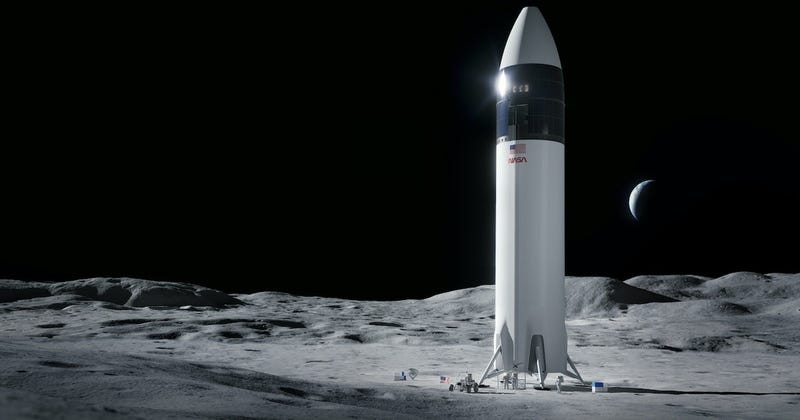Fresh footprints on the Moon aren’t likely to happen in 2025 as NASA hoped. A new report warns of significant delays to the Artemis 3 mission, the result of two key contractors—SpaceX and Axiom Space—not being able to deliver the goods on time.
The latest Government Accountability Office (GAO) report, published November 30, highlights major hurdles in the development of key components for NASA’s Artemis 3 mission, including SpaceX’s lunar lander and Axiom Space’s moonsuits. Delays, technical challenges, and an ambitious schedule may lead to a significant postponement of the mission, potentially impacting NASA’s lunar exploration timeline, the GAO warned. Artemis 3 is a planned NASA mission aimed at landing two U.S. astronauts, including the first woman and the next man, near the Moon’s south pole.
Should these challenges persist, and if these projects adhere to previous NASA development timelines, the Artemis 3 mission is unlikely to occur before 2027, according to the report. This would result in a considerable gap between missions, as Artemis 2—a crewed journey around the Moon—is scheduled for November 2024. The delay would also likely push back subsequent Artemis missions, with Artemis 4 currently planned for 2028, followed by Artemis 5 through 7 expected to transpire annually starting in 2029.

SpaceX is in the midst of developing Starship, the upper stage of which will serve as the human landing system for Artemis 3, transporting two astronauts to the lunar surface for a one-week stay. This contract, signed in 2021, is worth $US2.9 billion; a second SpaceX contract for a second lander was signed in 2022, worth $US1.15 billion. However, the GAO report highlights delays in testing the revolutionary megarocket, which could result in cascading schedule setbacks. The report points to a significant amount of complicated work that remains undone, leading to the grim conclusion that the first crewed lunar landing since the Apollo 17 mission in 1972 is unlikely to happen within the 2025 target.
As the GAO points out, SpaceX’s goal of developing and launching in 79 months—13 months quicker than NASA’s average project timeline—presents a formidable challenge given the complexity of human spaceflight. If the project adheres to the typical NASA timeline, Artemis 3 is more likely to take place in early 2027, as opposed to the current—and overly optimistic— schedule, the GAO concluded.
The GAO says that, as of September 2023, Starship experienced delays in eight of 13 key milestone events, with each setback adding several months to the overall schedule. Starship’s inaugural flight test, which happened on April 20, was itself delayed by seven months. Due to issues at the launch pad, such as the lack of protective infrastructure, and in-flight irregularities, namely a malfunctioning self-destruct sequence, the two-stage rocket faced a considerable delay, with SpaceX finally conducting its second launch on November 18. The latest report from the GOA, released this week, does not include the second test in its evaluation. However, it’s unlikely that including this test would have changed any of the report’s conclusions.
Related article: What’s Next for SpaceX’s Starship After Explosive Second Launch
A considerable amount of complex Starship-related work still needs to be done in advance of Artemis 3, “including developing the ability to store and transfer propellant while in orbit,” as a “critical aspect of SpaceX’s plan for landing astronauts on the moon for Artemis III is launching multiple tankers that will transfer propellant to a depot in space before transferring that propellant to the human landing system,” the report stated. At the same time, and as the GAO points out, NASA has noted limited progress in developing the necessary technologies for this aspect of the plan.
Axiom Space, responsible for developing Artemis 3 moonsuits, also faces design challenges, specifically the absence of an emergency life support system in NASA’s original design for the Artemis 3 mission (NASA provided Axiom with its design plans prior to handing off the baton). As the GAO report warns, Axiom may need to redesign parts of the suit, potentially causing delays in its delivery for the mission. Under the $US228.5 million contract signed in 2022, Axiom is tasked with designing, building, and testing the spacesuits ahead of Artemis 3.
NASA is currently adapting to the dynamics of working with numerous private contractors, who often propose timelines that are overly optimistic. It’s becoming increasingly important for NASA to approach these forecasts with a healthy dose of skepticism and adjust its own schedules accordingly.
Sure, this approach may give the impression of slow progress, but it’s a realistic response to the complexities of such projects. Should public impatience arise, NASA could rightly point to constraints like congressional underfunding. Ultimately, ambitious technological endeavors typically entail significant delays in development, a fact that both NASA and its partners seem reticent to accept.
Want to know more about humanity’s next giant leap in space? Check out our full coverage of NASA’s Artemis Moon program, the new Space Launch System (SLS) rocket and Orion spacecraft, the recently concluded Artemis 1 mission around the Moon, the four-person Artemis 2 crew, NASA and Axiom’s Artemis Moon suit, and the upcoming lunar Gateway space station. And for more spaceflight in your life, follow us on X (formerly Twitter) and bookmark Gizmodo’s dedicated Spaceflight page.
